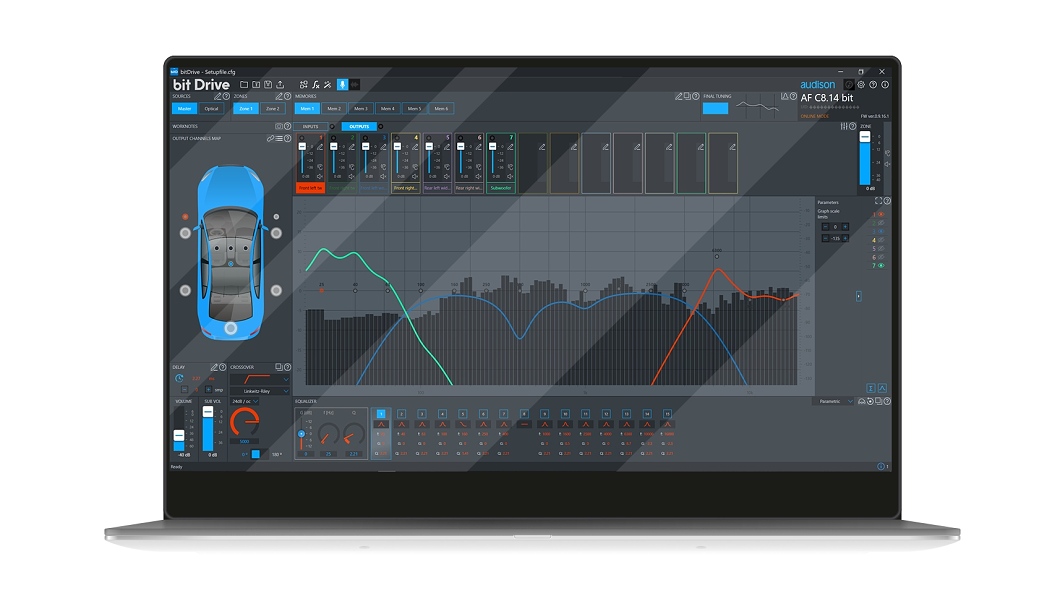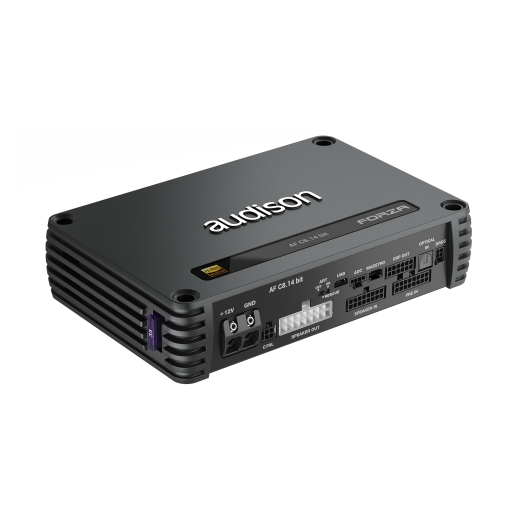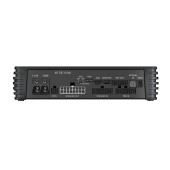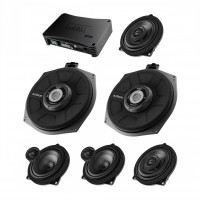Amplifier with DSP processor Audison AF C8.14 bit
More about the product
- Use our consulting room
- You can return the goods to us within 14 days
- Try the product at our store
Amplifier with DSP processor Audison AF C8.14 bit
The Audison AF C8.14 bit from the latest generation of Forza amplifiers from 2022 boasts eight high-fidelity amplified channels of 65W x 8 @4Ω, 100W x 8 @2Ω with audiophile sound thanks to the latest generation of Audison D-Class technology. Higher switching frequency, steeper filtering and higher tolerance components deliver sound beyond Class D expectations - in an amazingly compact package! This is combined with a native DSP operating at 24 bit/96 kHz, extending the audio bandwidth up to 40 kHz and obtaining the coveted High-Resolution certification. The amplifier can also be bridged, which enables flexible and powerful performance. The support of the Audison B-CON Absolute Volume function guarantees maximum bit depth, even with a wireless connection.New DSP tuning software
Audison's brand new Bit Drive PC software can analyze, route and correct your signal in completely new ways - now you can measure, mix and ultimately tune your sound with one powerful tool! The new graphical user interface simplifies every control and function, integrates acoustic measurements and ensures efficient tuning and great sound! Acoustic RTA is integrated into the EQ graph and is compatible with your USB microphone or sound card. The Final EQ function allows for final equalization without damaging the delicate relationships between left and right frequencies. Six processed preamplifier outputs are in addition to eight amplified channels, allowing Forza's DSP section to easily manage a larger system.
Advanced OEM integration capabilities
Eight Forza analog inputs plus a Toslink optical digital input support full connectivity with even the most complex OEM systems. If more analog inputs are needed, the optional F4IN expansion card adds four more analog input channels! If coaxial SPDIF or a second Toslink SPDIF input is required, an optional F2O expansion card can be used. Audison's classic de-EQ process is combined with de-Time and de-Phase to restore sound in almost any OEM system. Electrical signal analysis ensures proper integration and correction for each input and output channel. Built-in Universal Speaker Simulation (USS) technology provides maximum compatibility with any OEM source without muting or instability.
The AF C8.14 bit includes a set of six high-quality cables supplied with a protective printed tape placed in front of the Molex connectors to increase resistance to twisting:
- Pre-In with 8 stereo RCA connections for additional sources with PRE-OUT outputs
- Speaker-In with 8 pairs of labeled cables for OEM sources with high level outputs
- Speaker-Out with 8 labeled cables to connect the amplifier to the speakers
- Dsp-Out with 6 labeled cables to connect the amplifier to one or more accompanying amplifiers
- Forza Control cable with 2 wires for remote signal on and off, plus 2 wires for functions programmable in bitDrive software.

| Catalog number | AF C8.14 BIT |
| Brand | Audison |
| Links | Official web presentation (English) |
| Number of amplifier channelsAmplifiers are divided into: - Monoblocks - 2-channel - 3-channel - 4-channel - 5-channel - 6-channel - multi-channel Each channel is used to power one speaker for the coaxial type, or one side if they are component speakers. Monoblock type amplifiers are mainly used for subwoofers. 2-channel are suitable for both subwoofers and, for example, the front pair of speakers in a car. 3-channel is used for front or rear speakers + subwoofer. 4-channel are used for front + rear speakers or 1 pair of speakers + subwoofer. 6 or 5-channel are used for 2 pairs of speakers + subwoofer, most often. Bridging means connecting the amplifier to a bridge, using the + pole from one channel and the - pole from the other channel. In most cases this is shown as "BRIDGED" on the amplifier. | 8 |
| Energy class of the amplifierAmplifiers are divided into two basic classes: analog and digital . Analog amplifiers (A/B) have higher consumption requirements, but usually have a more natural sound. Digital amplifiers (D) have significantly lower consumption and higher efficiency, but the sound may not be as faithful as with classic analog amplifiers. | D |
| RMS power into 4 ΩRMS power when loading speakers or subwoofer at 4 Ω. RMS power is the constant power of the amplifier and is one of the most important parameters when choosing an amplifier. | 8 x 65 / 4 x 200 W |
| RMS power into 2 ΩRMS power when loading speakers or subwoofer at 2 Ω. RMS power is the constant power of the amplifier and is one of the most important parameters when choosing an amplifier. | 8 x 100W |
| Frequency rangeThe ability of the amplifier to reproduce the signal from the lowest frequency to the highest = faithfully reproduce the sound in a specific frequency band. Professionally: In the frequency range from 40 to 16,000 Hz, the vast majority of fundamental and overtones (harmonics) of all musical instruments are found. We are interested in the course of the radiated sound pressure in this range of frequencies when the loudspeaker system is supplied with constant power. We call this course the frequency characteristic, which tells us the level of radiated sound pressure in decibels (dB) depending on the frequency. The frequency characteristic of a speaker or speaker system can be expressed most succinctly with a graph. Mostly, however, the frequency characteristic is indicated by indicating the maximum tolerance of the sound pressure in the given frequency range, e.g. 50 to 15,000 Hz -+ 6 dB. Since the frequency characteristics of loudspeakers and systems in general are quite uneven, some manufacturers do not even specify this maximum tolerance of sound pressure in decibels in their catalogs for reasons of prestige. Data impoverished in this way is unfortunately worthless. What is valid is that the manufacturer offers a speaker system with a frequency range of 30 to 20,000 Hz, if he is worried about stating the maximum unevenness of the sound pressure in this range, because he can have a tolerance of, for example, +- 20 dB. The unevenness or undulation of the frequency curve in good speaker systems for high-quality music performance should not exceed +-3 dB in the 80 to 12,000 Hz band and +-6 dB in the 40 to 16,000 Hz band. Greater unevenness already depletes or emphasizes certain tonal areas, which can cause audible or even disturbing distortion. The proportion between fundamental tones and higher harmonics also changes, thereby changing the color of the sound, and individual musical instruments as well as the entire musical image sound unnatural. | 10 - 42000 Hz |
| Harmonic Distortion (THD)Total harmonic distortion indicates how much the input signal is distorted in the amplifier. Distortions appear as overtones contained in the output signal. The proportion of originally absent parts of the signal is given as a percentage, typical values are between 0.001% and 0.5%. Distortion is measured in their power band. If it exceeds the limit of 0.7% from a certain power, it is the value of the output power of the given amplifier, from which it no longer plays without distortion and from which the distortion usually increases steeply, so that no further increase in power can be counted on. The lower the value, the better. | 0.05% |
| Signal-to-noise ratioThe signal-to-noise ratio means that the output signal always contains noise. The signal-to-noise ratio expresses how much of this noise is compared to the useful signal. The so-called A value is given, which does not take deep and very high frequencies into account. This corresponds to the characteristic of human hearing, which is not so sensitive to deep frequencies, especially below 1 kHz. The higher the value, the better the amplifier is. | 105 dB |
| Input sensitivityIn order for the amplifier to perform its function correctly, it requires an input signal of a certain level, which is different for car radios. It is measured in "Volts" (e.g. 2 V, 4 V, etc.) The higher the value at the output of the pre-amplifier, or car radio, the less demands are placed on the power of the amplifier. However, the amplifier must allow this input sensitivity, and for that reason this value is also given for the amplifier. | 0.6 - 6 V |
| Damping factorDF - Damping Factor . It is the ratio of the load (repro + cables, crossover, etc.) to the internal resistance of the amplifier. The bigger the DF, the more controlled the bass. Amplifiers with a lower DF tend to hum. Subwoofers with a higher Q in the bass reflex and sometimes in the enclosure will also cause humming. | 85 |
| Socket input terminalsFerrule terminals allow better wiring contact to the amplifier. It is also a more secure form of terminals. If you are tightening the sleeve terminals, we recommend retightening them after 1 day, as the connected cable gradually compresses. | Yes |
| Dimensions of the amplifier | 200 x 47 x 134 mm |
| Mass | 1.49 kg |
























